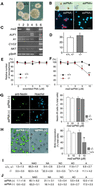RNA-binding protein Musashi family: roles for CNS stem cells and a subpopulation of ependymal cells revealed by targeted disruption and antisense ablation
- PMID: 12407178
- PMCID: PMC137566
- DOI: 10.1073/pnas.232087499
RNA-binding protein Musashi family: roles for CNS stem cells and a subpopulation of ependymal cells revealed by targeted disruption and antisense ablation
Abstract
Homologues of the Musashi family of RNA-binding proteins are evolutionarily conserved across species. In mammals, two members of this family, Musashi1 (Msi1) and Musashi2 (Msi2), are strongly coexpressed in neural precursor cells, including CNS stem cells. To address the in vivo roles of msi in neural development, we generated mice with a targeted disruption of the gene encoding Msi1. Homozygous newborn mice frequently developed obstructive hydrocephalus with aberrant proliferation of ependymal cells in a restricted area surrounding the Sylvius aqueduct. These observations indicate a vital role for msi1 in the normal development of this subpopulation of ependymal cells, which has been speculated to be a source of postnatal CNS stem cells. On the other hand, histological examination and an in vitro neurosphere assay showed that neither the embryonic CNS development nor the self-renewal activity of CNS stem cells in embryonic forebrains appeared to be affected by the disruption of msi1, but the diversity of the cell types produced by the stem cells was moderately reduced by the msi1 deficiency. Therefore, we performed antisense ablation experiments to target both msi1 and msi2 in embryonic neural precursor cells. Administration of the antisense peptide-nucleotides, which were designed to specifically down-regulate msi2 expression, to msi1(-/-) CNS stem cell cultures drastically suppressed the formation of neurospheres in a dose-dependent manner. Antisense-treated msi1(-/-) CNS stem cells showed a reduced proliferative activity. These data suggest that msi1 and msi2 are cooperatively involved in the proliferation and maintenance of CNS stem cell populations.
Figures




References
-
- Temple S. & Alvarez-Buylla, A. (1999) Curr. Opin. Neurobiol. 9, 135-141. - PubMed
-
- Sakakibara S., Imai, T., Hamaguchi, K., Okabe, M., Aruga, J., Nakajima, K., Yasutomi, D., Nagata, T., Kurihara, Y., Uesugi, S., et al. (1996) Dev. Biol. 176, 230-242. - PubMed
-
- Keyoung H. M., Roy, N. S., Benraiss, A., Louissaint, A., Jr., Suzuki, A., Hashimoto, K., Rashbaum, W. K., Okano, H. & Goldman, S. A. (2001) Nat. Biotechnol. 19, 843-850. - PubMed
Publication types
MeSH terms
Substances
LinkOut - more resources
Full Text Sources
Other Literature Sources
Medical
Molecular Biology Databases

